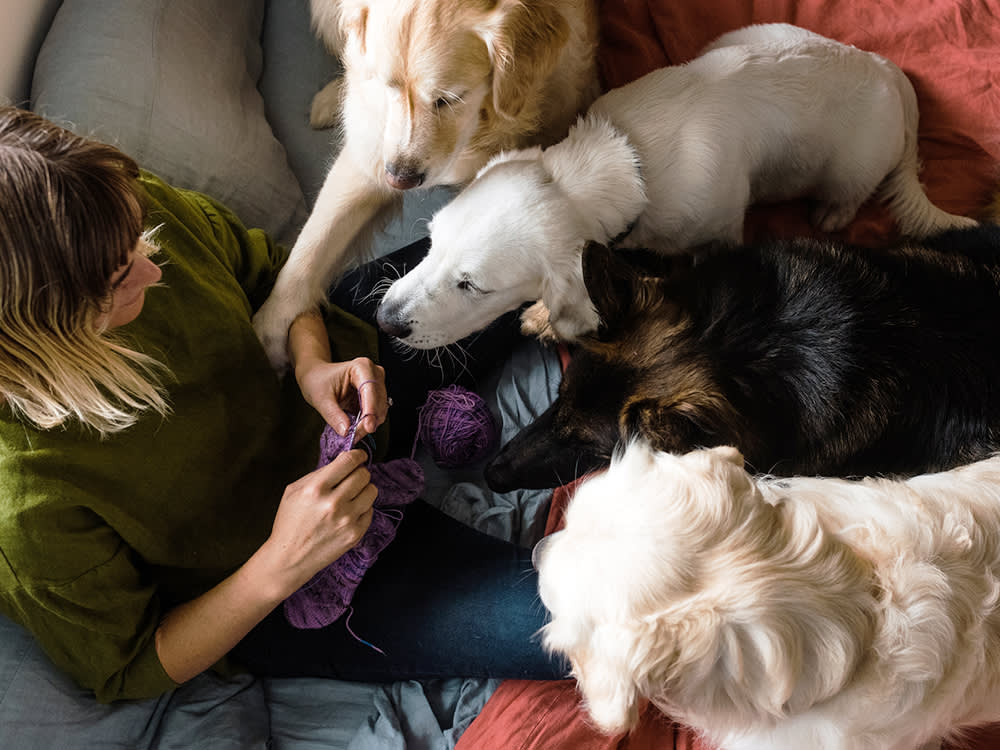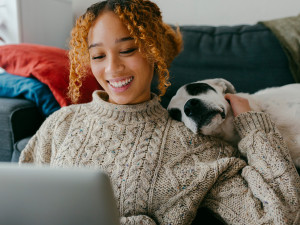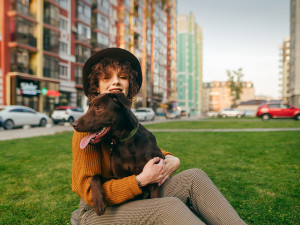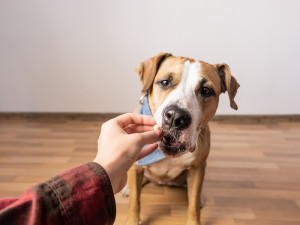Tips on Managing a Multi-Dog Household
The more, the merrier…except when it’s not.
Have you ever considered getting a second dog? How about a third dog? What about more? You aren’t alone. It’s hard to resist the allure of those cute scruffy faces. On a typical morning in a multi-dog household, you’re bound to see dogs romping around — playing, zooming, and rolling all in the course of an hour — it’s hard to imagine a better way to start the day.
Having a multi-dog household (three or more dogs) means three playmates instead of one and three dogs to comfort you when you’re down. With three, you’re more likely to have a snuggly companion on the couch or bed, and you’ll be welcomed home by three madly wagging tails. And living in a multi-dog household is also better for your dog. For one thing, you’re not solely responsible for their entertainment. They wear each other out when they play in a way that’s impossible for you to replicate.
Despite the many benefits of multi-dog homes, there are also costs, and they’re not all financial. Wiping 12 muddy paws or trimming 54 toenails is exponentially more tiresome than dealing with four paws or 18 nails. Walking three leashed dogs can be complicated, especially when your leashes get tangled with those attached to several dogs from another household. And, of course, training three or more dogs is harder than training one or even two, especially when it involves behaviors they tend to do in unison, like barking at the UPS man or rushing to the door when the bell rings. For many people, such training requires more time and patience than they have.
Dealing with aggression in a multi-dog household
Dogs don’t always get along, of course. Although a lot of “aggression” between familiar dogs is ritualized and harmless without biting, it sometimes escalates, especially when a new dog is involved. While researchers have not systematically observed multiple pet dogs living together, a few studies have examined data from canine behaviorists who had been consulted for help with intra-household aggression. Unfortunately, these studies do not involve a comparison group of households whose dogs do get along, which makes many of their findings hard to interpret. Nevertheless, they tend to agree on a few patterns: aggression is often instigated by a newly matured dog or by a new household member against an older dog, is more frequent within same-sex pairs, particularly when both dogs are female.
How much do you spend on your pet per year?
Aside from avoiding the most common triggers — such as resource guarding in the presence of food or toys; proximity to the pet parent; high-arousal situations, such as greetings or preparations to leave; and being together in a confined space, such as a narrow hallway — other treatment recommendations include medications such as fluoxetine (Prozac) and following a “nothing in life is free” program.
Some canine behaviorists encourage people to consistently favor one dog over the others (e.g., the older or higher-ranking dog) by giving them resources and attention first. Behaviorist Patricia McConnell argues against this because, in her experience, it doesn’t work. She suggests other methods of decreasing intra-household aggression, including training dogs to be in close proximity to one another while waiting in turn for a resource.
In one example of dogs highly trained in this method, McConnell asks three Border Collies and a Great Pyrenees to line up, then kneels in front of them holding a pan in which meat has been roasted. By name, she calls one dog forward to lick the pan, then asks that dog to stop licking and back up when it is the next dog’s turn. Her dogs’ body language indicates how much self-control they must exert to succeed in this situation, but succeed they do. The lesson? When dogs learn that they get what they want by politely waiting their turn, they are less likely to bully each other (or you!) as a way to gain resources.
When intra-household aggression is a serious problem, consult a certified canine behaviorist with a background in this type of situation. In addition, it can be very helpful to learn as much as possible about canine communication to better understand dogs’ interactions. For example, being tuned in to postures and facial expressions that often precede aggression — such as a dog standing very still with his muzzle tightly closed — can allow us to intervene before an attack is launched.
Who is the leader of the pack?
More often than not, multiple dogs do get along. Based on my own experience, I hypothesize that relationships between a household’s humans and dogs, as well as relationships among the humans, influence how dogs get along. People who model peaceful, generous, and courteous behavior create a household culture that dogs, who are highly attuned to social etiquette, recognize. Puppies growing up in such households are especially likely to adopt that culture.
One of my favorite group activities involves walking my dogs off-leash in wild areas far from roads. Each dog understands that when I say, for example, “Max, lead!” I will follow the dog who has been singled out so long as they don’t move toward anything dangerous. All my dogs love being the leader yet will relinquish that role when it’s the next dog’s turn — or mine. It’s fascinating to see where each dog chooses to go; their noses lead us to places I might never find. Also, I can relax because I’m not making all the decisions; it’s fun to be a follower for a change. Finally, letting the dogs be in charge helps balance power in the human-dog relationship. None of my dogs has mutinied, which I think effectively demonstrates that we don’t always have to be “the decider” to have well-behaved dogs.
Based on what scientists know about people, dogs, and their mutual histories, these outings in some ways mimic the original relationship between human hunter-gatherers and canines. Hunters traveled with multiple dogs, some of whom tracked and chased game while others protected women and children when they were out foraging. Since dogs can smell and hear better than we can, as well as see better in the dark, it made sense for our ancestors to sometimes defer to canine judgments about where to go (or not go). Most of the time, you can’t live this way, but you can get a taste of the wild by going on long outings and allowing your dogs to lead.
Relationship dynamics of multiple dogs
Another plus to living with multiple dogs is the opportunity to observe relationship dynamics. Groups of dogs are systems, which means that if any part changes, everything else changes as well. Through such observations, I’ve learned that dogs take their relationships with one another seriously. Old friends whose interest in playing together gradually decreased over the years may be energized when a new dog joins the family, and in turn, they may spend more time playing with one another.
Several years ago, I lived with three female dogs; at one point, they were joined by Osa, a middle-aged male who needed a temporary home. Safi, the undisputed lead dog in my group, had known Osa well five years earlier, and they began playing almost immediately.
However, Safi was by then older and weaker than Osa, and she objected to some of his rough play moves. After clearly communicating this several times, she lost patience and moved to discipline him. Instead of submitting, Osa grabbed Safi’s neck and briefly forced her to the ground. Less than a minute later, Safi approached Osa to reconcile (more about this behavior follows), but he ignored her. From that moment on, Safi gave Osa the cold shoulder, refusing to interact with him in any way. The other two females, who had merely witnessed the event, also ceased engaging with Osa, even though both had played with him before. To my amazement, all three females ostracized Osa during the rest of his stay, a full seven weeks. I was reminded of situations in human families in which people refuse to speak to one another for years.
Watch for reconciliation among dogs
I urge people who live with several dogs to pay attention to their interactions. One thing to look for is reconciliation behavior. Research shows that shortly after a two-way conflict within their group, dogs and wolves tend to approach the former opponent to do something nice, like touch muzzles or invite play. Dogs and wolves are especially likely to reconcile when they place a high value on a relationship, and “making up” can be a window into their feelings. For example, a dog that sometimes gets grumpy when playing may, a few moments later, offer a muzzle lick. The same study documenting reconciliation in dogs also showed that if the combative parties fail to reconcile shortly afterward, a third dog, uninvolved in the event, is likely to approach the “victim” of the squabble in a friendly manner, perhaps to offer comfort.
Notice, also, the way dogs who live in the same household behave when they meet another dog. Many times, I have seen them close ranks when an unfamiliar dog exhibits the slightest unfriendly move toward one of their own. If that behavior escalates to a real threat or fight, a dog may intervene directly to defend a housemate. Such defense is particularly striking when a dog supports someone they don’t especially like when they’re at home.
Because we’re humans, we focus on our dogs’ relationships with us. But the most amazing thing about dogs is their capacity to become integrated into both human and canine society. In the past, dogs usually lived in multi-dog, multi-human groups. Multi-dog households are, in a sense, their birthright. No matter how much we love our dogs, to be fulfilled, we need other people, and no matter how much dogs love us, they need other dogs to experience and express all of who they are.





